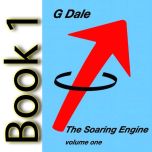Searching the Sky

Searching the sky for the best lift is endlessly challenging. Decision-making is essentially a three-stage procedure. Firstly, continually analyze all relevant factors – the wind, sun, ground surface, and the shape and texture of the clouds throughout the flight. Secondly, use all your experience of ridges, convergence, wave, thunderstorms to process this information. Then try to build a mental picture that helps you plot the movements of the ocean of currents ahead. Thirdly, where you search for lift depends ultimately on your height. When cruising in your comfort zone, pay more attention to the activity at cloud base. When descending into the bottom half of convection, focus on monitoring ground features.
Absorb Information
The first part of this is absorbing information, it demands a real thirst for knowledge. Flying with John Buchanan for the first time, it rapidly became apparent that he devoted far more of his energies looking outside than I had ever thought necessary. This attentiveness meant he was always the first to notice birds circling or tendrils being sucked into cloud base. An acute awareness of the wind direction is equally important. Try to assess the local wind direction using whatever indicators are available. Based on this, imagine the wind flowing like a fluid over the terrain below you. Then you can visualize what it is doing and create a mental picture of it squeezing through narrow valleys or spilling around ridges over which you may be flying.
Sun Angle to the Ground
Another thing to look for is the angle of the sun to the ground. What might the effects be of the sun passing from east to west through the day and of its height at different times of the year or in different latitudes? For example, have you ever experienced an inexplicable lull in thermals in the early afternoon, just as you get into the rhythm of a good flight? The cooling shadow cast on the ground by your cloud falls directly upon the very area of hot buoyant air that is feeding the thermal. Later in the day, the angled sun is better able to provide energy directly under the cumulus to reinforce your thermal.
Putting the Picture Together
Once you’ve gathered your information about the effects of the sun’s heating and monitored the wind, you then have to process this information to build a mental picture of what’s going on. Noticing even a change of wind direction of as little as 30° could be enough for you to exploit a developing convergence line.
When soaring the kind of storms we get in Australia, one needs to think carefully about how the air is moving on a large scale. With wind speeds on the ground fluctuating by up to 50 kts at a time, you need to cultivate the big picture of how storms work. These storms throw out violent dust fronts at ground level as it's kicked up off the ground. Dropping into such dust fronts yields only turbulence & can be dangerous, but they often force the air in front up into the leading edge of the storm. This forms thick, dark, tendril-ridden lines of lift that you can ride for hundreds of kilometers. The best place to run is under the dark shelf, normally between one and five kilometers out. There are, however, risk-reward trade-offs to be made: how close would you fly to a wall of lightning to get a line of 10 kt lift?
So, once we’ve pieced our jigsaw together where do we actually point the glider?
Searching at Cloudbase
Use your time climbing to pick your route ahead. At cloud base, the deterioration in horizontal visibility makes it difficult to choose the best direction. If, however, you are forced to make a decision at cloud base, rely on the shadows cast on the ground ahead. This will show in which direction the clouds line up best. When deciding which clouds will give the best lift, it is more important to concentrate on what the bases look like than the tops. Search for the darkest flattest bases from the side, but when you arrive under cumulus look for the discontinuities in the base.
When picking your route, try and work out if the lift is located consistently relative to the cu on a given day. This will be more predictable on some days than others. Even when you can reliably find lift, the effect of the sun moving from east to west may cause the thermals to shift. Remember too, that the picture looks completely different when you change directions. To avoid disorientation after rounding a turning point, spend time looking down the next leg before you turn.
When you’ve decided where you think the strongest lift is, what’s the best way to search under the cloud? To maximize the number of thermals you sample, fly to the side of the cloud you think looks best and then turn towards the middle. I often S-turn three or four times under a cloud before I decide either to press on or stop to climb.
Practice
In order to get the most out of the sky when flying cross-country, you need to practice. The best way to do this is by racing against friends in similar gliders. At the competition level, you will see relatively small differences in climb performance. However, in the glide, the good guys can pull out surprisingly big leads by working the energy efficiently. My advice to any pilot hoping to make the most of the weather is to race, compare, and learn.
Banner photo was taken by Sophie Mahieu





